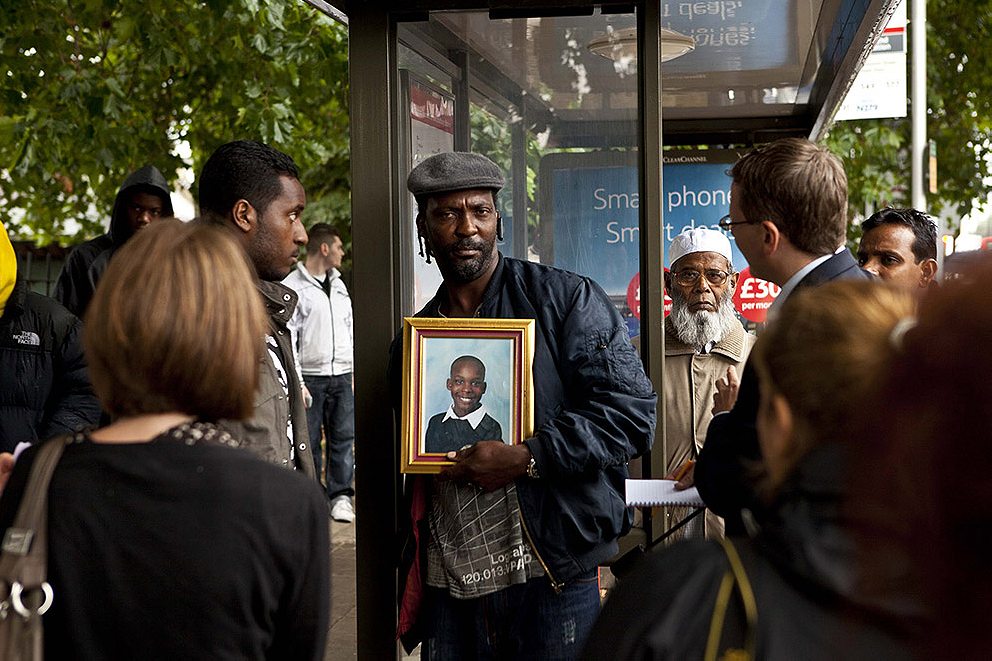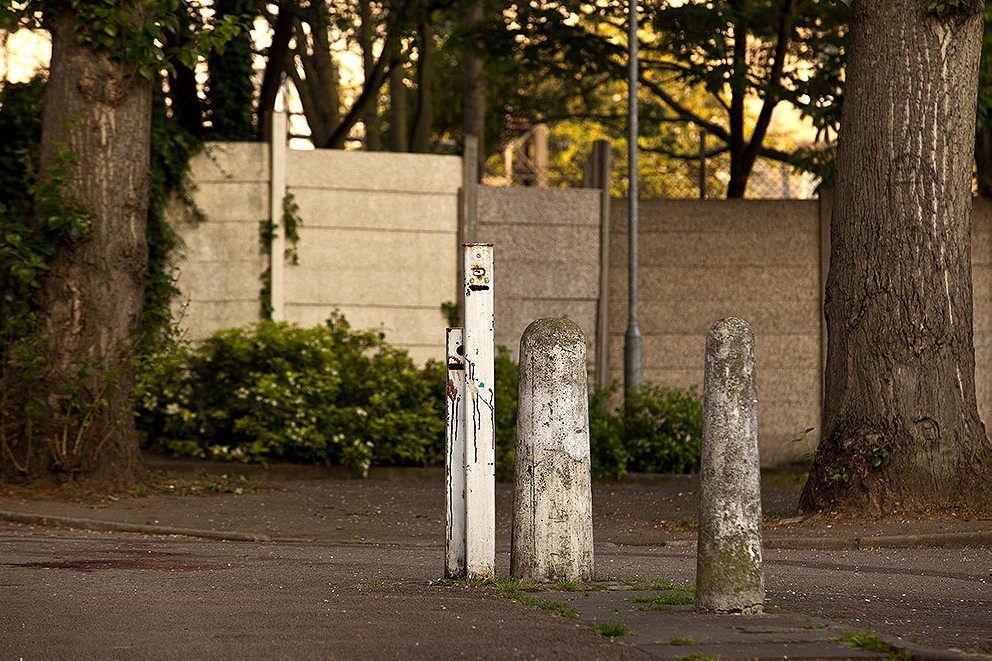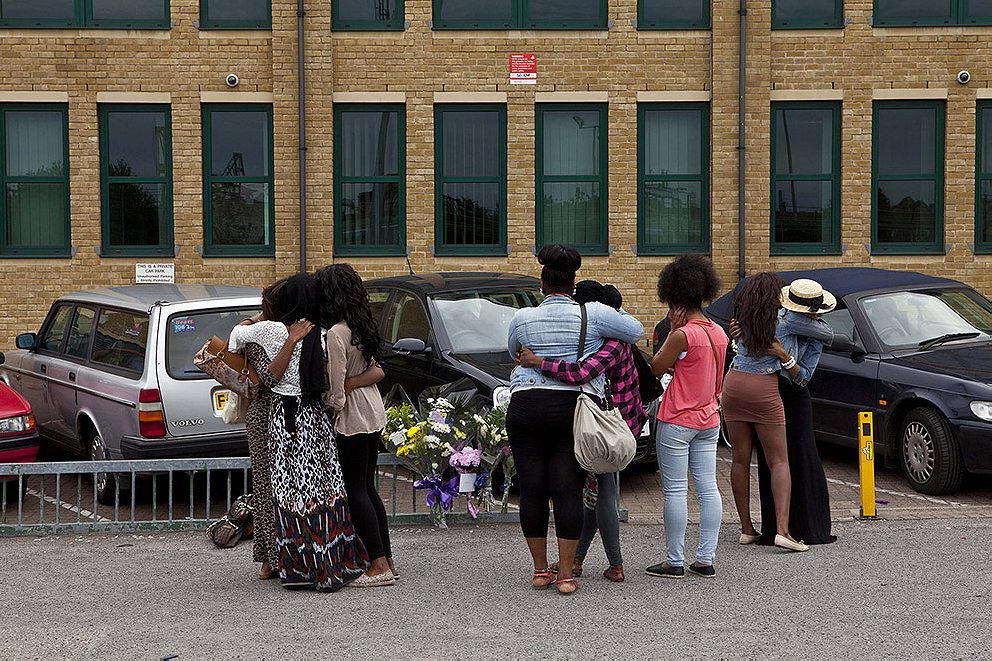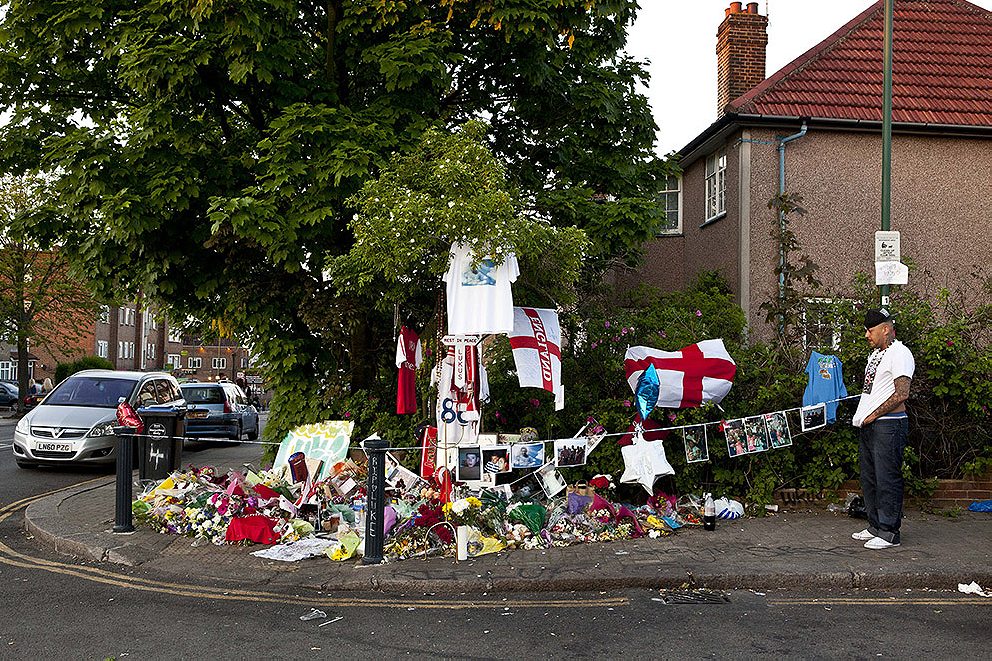By photographing the site of every murder that occurred in London over a two year period, a Mexican-born photographer presents an alternative portrait of the city he calls home.
Two hundred and ten. That’s the number of people who were murdered in London between January 1st, 2011 and December 31st, 2012. It’s also the number of photographs in Antonio Zazueta Olmos’ series, “The Landscape of Murder.” In his spare time the Mexican-born photographer visited each murder site, usually within a few days of each crime, and documented what he found. 79 pictures from that series made it into his new book by the same title. Far from being a sensationalist leer at violence and gangs, it’s a remarkably unique view of London, “an alternative portrait” says Olmos, of the city where he has lived for twenty years. He talked with R&K about “The Landscape of Murder” from his home in London.
Roads & Kingdoms: What were your first impressions of London when you moved there?
Antonio Zazueta Olmos: I moved to London the mid-90s. While living in Mexico City, I fell in love with a British woman who grew up in Nicaragua. I was happy in Mexico but struggling financially, where here in London I found it easy to get commissioned work. My first impression was that the sun never shines and that got me down a bit. But I felt every door was open to me in regards to editorial work. No one gave a shit where I was from in London, my portfolio was all that mattered. One of my first assignments was to do a portrait of Leonard Cohen in Oslo. I was sent to Africa by the BBC News Magazine; The Independent and The Observer gave me lots of portrait work. Soon, NGOs and magazines took a chance with me and started sending me abroad to do reportage work.
I want to be a storyteller more than a conflict photographer.
R&K: You’ve traveled a lot for work, sometimes covering conflict. How do you see your “The Landscape of Murder” project fit in your career? I’m amazed that you are still inspired by the city you’ve lived in for such a long time.
AZO: It’s a different direction for me. The world of photojournalism is changing. I think people like me have to look closer to home to make work that stands out. It’s easy to photograph the exotic, but much more difficult to shoot something you see everyday. I think the days of being paid to travel and work say in Iraq or Africa or the Middle East are changing. The idea that you can’t find a top notch photographer in Bangladesh to do a commission for you is really ludicrous. So to stay relevant I have to look closer to home. And I won’t do news coverage again, this I know. First I can’t do it financially, and even if I did, what would I be doing? I would be taking the same pictures as every other wannabe photojournalist… I want to be in situations where not a single other photographer is standing next to me. I want to be a storyteller more than a conflict photographer, and explore more meditative and contemplative ways of looking.

R&K: I actually found out about your project because I lived two years in Dollis Hill and Willesden Green. And when I came across the photos you took there, it really touched me. These places were relatively quiet suburbs, but occasionally we would hear of violence or murders. In the end though, they were quite mundane London neighborhoods, and that seems an important aspect in your work…
AZO: Wow. Well thanks. I don’t know how my photos fly abroad but people in London really react to them. I think it makes them look at the city again. I sometimes say the subtitle of my work is “an alternative portrait of London.” I like working in non-tourist London… I learned more about London in the two years of the project than I did from 20 years of living here. People think they know London but they don’t.


R&K: Was the idea to show that these murders could happen anywhere?
AZO: The project started because a woman was murdered a few blocks from me, in a house that looked exactly like mine. It never made any news. She was killed by her partner. If she had been a black teenager in a gang, wielding a knife it would have been all over, but because women getting killed by men does not feed into our fears of crime or fits the stereotypes, it gets no coverage. That idea intrigued me. The second murder—an Asian woman killed by her family—again did not make the news. Murder is not random at all. You know your killer 99% of the time.
R&K: How did you find out about the murders if they were not reported?
AZO: The police have a website that tells you everything they are doing. No one ever looks at it except crime reporters. After a while I learned to follow reporters on twitter that covered murders and bloggers who write about their neighborhoods. Soon I had a whole network of info.
Violent crime is rarely a stranger coming through your window.
R&K: It seems you aren’t interested in being the first on site. Do you wait a couple of days before visiting the place of the murder?
AZO: I always waited a few days because if I went right away, I would be confronted by the same thing: police cars, police tape, policemen keeping me away from what I wanted to photograph. When a murder happens, they keep everyone away, including family and friends. But after a day or two that changes, and I would sometimes be confronted with people mourning the loss of a loved one. I made a conscious choice that if I had people in my photos I would ask permission, so everyone in my photos gave me their consent. I asked, explained what I was doing and 90% of the time they said yes. The only time I got aggression was murders involving gangs, and that just happened twice in a two-year period at 210 scenes.
Crime has been going down in London for a hundred years.
Two hundred and ten. That’s the number of people who were murdered in London between January 1st, 2011 and December 31st, 2012. It’s also the number of photographs in Antonio Zazueta Olmos’ series, “The Landscape of Murder.” In his spare time the Mexican-born photographer visited each murder site, usually within a few days of each crime, and documented what he found. 79 pictures from that series made it into his new book by the same title. Far from being a sensationalist leer at violence and gangs, it’s a remarkably unique view of London, “an alternative portrait” says Olmos, of the city where he has lived for twenty years. He talked with R&K about “The Landscape of Murder” from his home in London.
Roads & Kingdoms: What were your first impressions of London when you moved there?
Antonio Zazueta Olmos: I moved to London the mid-90s. While living in Mexico City, I fell in love with a British woman who grew up in Nicaragua. I was happy in Mexico but struggling financially, where here in London I found it easy to get commissioned work. My first impression was that the sun never shines and that got me down a bit. But I felt every door was open to me in regards to editorial work. No one gave a shit where I was from in London, my portfolio was all that mattered. One of my first assignments was to do a portrait of Leonard Cohen in Oslo. I was sent to Africa by the BBC News Magazine; The Independent and The Observer gave me lots of portrait work. Soon, NGOs and magazines took a chance with me and started sending me abroad to do reportage work.
I want to be a storyteller more than a conflict photographer.
R&K: You’ve traveled a lot for work, sometimes covering conflict. How do you see your “The Landscape of Murder” project fit in your career? I’m amazed that you are still inspired by the city you’ve lived in for such a long time.
AZO: It’s a different direction for me. The world of photojournalism is changing. I think people like me have to look closer to home to make work that stands out. It’s easy to photograph the exotic, but much more difficult to shoot something you see everyday. I think the days of being paid to travel and work say in Iraq or Africa or the Middle East are changing. The idea that you can’t find a top notch photographer in Bangladesh to do a commission for you is really ludicrous. So to stay relevant I have to look closer to home. And I won’t do news coverage again, this I know. First I can’t do it financially, and even if I did, what would I be doing? I would be taking the same pictures as every other wannabe photojournalist… I want to be in situations where not a single other photographer is standing next to me. I want to be a storyteller more than a conflict photographer, and explore more meditative and contemplative ways of looking.

R&K: I actually found out about your project because I lived two years in Dollis Hill and Willesden Green. And when I came across the photos you took there, it really touched me. These places were relatively quiet suburbs, but occasionally we would hear of violence or murders. In the end though, they were quite mundane London neighborhoods, and that seems an important aspect in your work…
AZO: Wow. Well thanks. I don’t know how my photos fly abroad but people in London really react to them. I think it makes them look at the city again. I sometimes say the subtitle of my work is “an alternative portrait of London.” I like working in non-tourist London… I learned more about London in the two years of the project than I did from 20 years of living here. People think they know London but they don’t.
R&K: Was the idea to show that these murders could happen anywhere?
AZO: The project started because a woman was murdered a few blocks from me, in a house that looked exactly like mine. It never made any news. She was killed by her partner. If she had been a black teenager in a gang, wielding a knife it would have been all over, but because women getting killed by men does not feed into our fears of crime or fits the stereotypes, it gets no coverage. That idea intrigued me. The second murder—an Asian woman killed by her family—again did not make the news. Murder is not random at all. You know your killer 99% of the time.

R&K: How did you find out about the murders if they were not reported?
AZO: The police have a website that tells you everything they are doing. No one ever looks at it except crime reporters. After a while I learned to follow reporters on twitter that covered murders and bloggers who write about their neighborhoods. Soon I had a whole network of info.
Violent crime is rarely a stranger coming through your window.
R&K: It seems you aren’t interested in being the first on site. Do you wait a couple of days before visiting the place of the murder?
AZO: I always waited a few days because if I went right away, I would be confronted by the same thing: police cars, police tape, policemen keeping me away from what I wanted to photograph. When a murder happens, they keep everyone away, including family and friends. But after a day or two that changes, and I would sometimes be confronted with people mourning the loss of a loved one. I made a conscious choice that if I had people in my photos I would ask permission, so everyone in my photos gave me their consent. I asked, explained what I was doing and 90% of the time they said yes. The only time I got aggression was murders involving gangs, and that just happened twice in a two-year period at 210 scenes.
Crime has been going down in London for a hundred years.
R&K: Did people seem shocked or was that something they lived with on a daily basis?
AZO: No, this is not Syria and it doesn’t happen on a daily basis. It’s not even Chicago or Detroit by any stretch of the imagination. Crime has been going down in London for a hundred years. London is one of the safest cities in the world in an urban area of 10 million. They are shocked because it happened to them. One of the points that I wanted to explore was that we don’t understand crime or murder. Violent crime has more to do with mental illness, domestic violence, organized crime, too much alcohol… It’s rarely a stranger coming through your window.
R&K: Why do you think domestic violence is so unreported? In your opinion, is it a universal thing?
AZO: I suspect it is under-reported everywhere. I wondered about that a lot. I think for a certain types of media like tabloids, right wing papers, etc., domestic violence is not very interesting. I would sometimes be at a scene and a reporter would ask what happened, and when I said domestic violence, he would close his notebook and walk away. I think certain media cover crime to create fear. Fear of immigrants, fear of ethnic minorities, fear of poor people even… And murderous violent men of all classes and colors killing their partners does not fit into that stereotype.
R&K: That’s incredibly depressing. Do you think reporting on these issues more would help to make them less frequent?
AZO: I don’t know. I think more social equality and better education would help. I am hoping that after the book comes out, my work will have a second life helping organizations dealing with domestic violence, for example… I think empowering women on all levels will do the most to help. Women who feel they have choices are less likely to end up with violent partners.
R&K: Are you involved in NGOs at all or do you see your role more as an observer?
AZO: I am talking to a couple of charities that deal with domestic violence. I might do an exhibition of just the photos where the victims are just women. I am a human being first and foremost. If I can help, I certainly will. Photography does demand a certain amount of detachment, but to what degree depends on the photographer.
“The Landscape of Murder” will be published on November 14. You can pre-order the book here